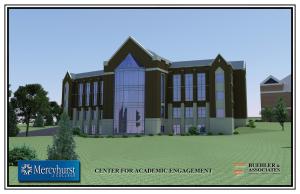Mercyhurst College plans to begin construction on its $9 million academic building in the spring.
“We are mostly ready to go in terms of finance of the building,” Vice President for Advancement David Livingston, Ph.D., said.
The plan is to begin construction in March 2011 and have the building ready for fall 2012.
 Contributed photo: The new academic building is scheduled to open in fall 2012.
Contributed photo: The new academic building is scheduled to open in fall 2012.
The Center for Academic Engagement, which is the “working title of the building” according to Vice President for Academic Affairs Phil Belfiore, Ph.D., will house both the undergraduate and graduate intelligence studies programs and the hospitality management department.
The Applied Politics Center and Evelyn Lincoln Institute for Ethics & Society will reside in the new building as well.
The communication department and graphic design department will have some of their classes in the new building, but as of right now, the faculty’s offices will stay on the bottom floor of the Hirt Academic Center, Belfiore said.
The deciding factor to move these departments “would have to be if we have adequate space to move them,” Belfiore said.
If there is not enough office space to move the entire faculty from a department, none of the faculty will move, Belfiore said.
 Ethan Magoc photo: The Center for Academic Engagement will be built where the maintenance building and parking lot are now located.
Ethan Magoc photo: The Center for Academic Engagement will be built where the maintenance building and parking lot are now located.
He said he wants there to be room inside the building to accommodate department growth.
Priorities are another factor that determine if the communication or graphic design departments move into the new building.
As of now, lecture hall space is a priority in the new building, according to Belfiore.
Faculty and the college administration have been meeting to discuss these changes and what each department would like in the new building.
“We’re happy to be in the conversation,” said Director of Graphic Design Jodi Staniunas-Hopper.
Communication department chair Anne Zaphiris, Ph.D., said the communication department enjoys being part of the planning process as well.
Since nothing is set in stone, both Zaphiris and Staniunas-Hopper said it was too soon to comment on the decision for their departments to stay in Hirt but have classes in the Center for Academic Engagement.
The departments to be housed in the new building were chosen based on several factors.
Intelligence studies was chosen because “it’s one of our largest majors and because it’s not in the center of our Erie campus,” Belfiore said.
Intelligence studies is a growing major, and there is a need to create adequate space for the department, he said.
“We’ve outgrown this facility,” Associate Professor of Intelligence Studies Kristan Wheaton said about the current intelligence studies building. “There is simply no place for us to put all the things we have going on.”
After the intelligence studies major was chosen to be a part of the new building, the administration looked at which majors could benefit from the integrated computing centers that would be shared with intelligence studies.
Hospitality management was included in the building because it is growing in size, and the Grotto Dining Room, which serves as an instructional facility and restaurant run by students, is “small and inadequate,” Belfiore said.
According to Belfiore, the idea of the building is that Mercyhurst is involved with the world.
“All of these things engage in the world outside Mercyhurst,” Belfiore said. “Mercyhurst prides itself in that.”
The building will help students become more involved with campus and academic life.
“Our goal is to be able to get closer to other disciplines,” Wheaton said.
Belfiore referred to the academic building as a “showcase.”
“This building is designed to stand out,” Belfiore said. “We want to make sure the exterior stands out.”
The architects were asked to “design a signature building for academics and to complement Old Main,” said President of Buehler & Associates Inc. Shelane Buehler.
The Center for Academic Engagement will have similar characteristics of the gothic architecture as well as “portions and rhythms of Old Main,” she said.
The approximately 41,000-square-foot building will have four floors.
Hospitality management will take up the lowest level of the building. This level will include kitchens, classrooms and possibly a facility similar to the Grotto Dining Room where students can gain hands-on experience.
The ground floor will most likely consist of an atrium for students to work and study in, the Applied Politics Center, the Evelyn Lincoln Institute for Ethics & Society, several general-purpose classrooms and an auditorium.
This auditorium will be similar to Walker Recital Hall but will be “more for lectures and speakers than music events,” Belfiore said.
The second floor will have offices, computer labs, technology centers and specific purpose labs designed for intelligence studies, graphic design and possibly communication students to use.
The intelligence studies department will be on the third floor.
Although the intelligence studies department has its own building now, Belfiore said the department’s space will not decrease because faculty and students will be able to use the entire third floor and the technology labs on the second floor.
“It will be more condensed in the fact students will be able to work together,” Belfiore said.
He referred to small seminar work spaces and collaborative spaces that students will be able to take advantage of when working on projects.
Although most of the details of the building are not subject to change, the site of the building is not.
The Center for Academic Engagement will be built where the maintenance building and the parking lot of the maintenance building are now.
The academic building will be located south of the solar panels, so there will still be open grass area at the front of the school, Belfiore said.
Even though the site of the academic building is definite, the new site of the maintenance building has not been decided.
“We will probably have to use a temporary space during the 18 months of construction then develop a more permanent solution once the new building is up,” Livingston said.
As of now, there are no definite plans for the current Center for Intelligence Studies, 3928 Wayne Street. Livingston said the school will continue the lease on this building once the department is no longer there and find another use for it.
All aspects of the new building are tentative and could change in the next couple of months.
If all remains on schedule to break ground in March, bids must be sent to construction companies in late January or early February. Therefore, all final building decisions will be made by the first week of February, Livingston said.
